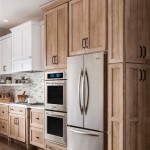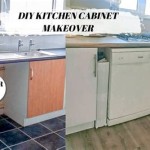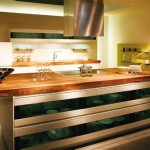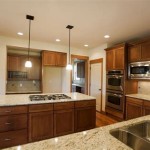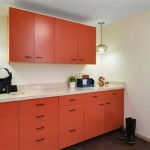Does Cabinet Refacing Really Work? A Comprehensive Examination
Cabinet refacing, also known as cabinet resurfacing, is a remodeling process involving replacing cabinet doors and drawer fronts while keeping the existing cabinet boxes in place. This technique offers a potentially cost-effective alternative to complete cabinet replacement, but its efficacy depends heavily on several factors. This article will explore the advantages, disadvantages, suitability, and best practices of cabinet refacing to determine if it truly “works” as a viable kitchen or bathroom renovation option.
The core appeal of cabinet refacing lies in its ability to transform the aesthetic of a room without incurring the extensive costs and disruption associated with a full cabinet tear-out. It's often marketed as a quicker, cleaner, and cheaper solution, but a thorough evaluation of its limitations is crucial. The condition of the existing cabinet boxes, the desired aesthetic changes, and the quality of materials and installation all play significant roles in the success of a refacing project.
One of the misconceptions surrounding cabinet refacing is that it will always be drastically cheaper than complete cabinet replacement. While it often falls within a lower price range, various factors can affect the final cost. The complexity of the existing cabinet configuration, the type of refacing materials chosen (e.g., wood veneer, laminate, rigid thermofoil), and the extent of any modifications needed to the boxes can all increase the overall expense. Therefore, obtaining detailed quotes from multiple contractors and carefully comparing them to the cost of replacement is essential.
Key Point 1: Assessing the Suitability of Your Existing Cabinets
The primary determinant of whether cabinet refacing is a viable option is the structural integrity of your existing cabinet boxes. Refacing is only suitable if the boxes are sturdy, level, and free from significant damage such as water damage, rot, or warping. Any pre-existing structural problems must be addressed before proceeding with refacing. Attempting to reface damaged cabinets is akin to putting a fresh coat of paint on a crumbling foundation; the underlying issues will eventually undermine the new finish.
Carefully inspect the cabinet boxes for signs of weakness. Check the joints to ensure they are solid and not pulling apart. Look for delamination or bubbling of the existing surface, which can indicate moisture damage. Pay particular attention to the areas around the sink and dishwasher, as these are particularly susceptible to water exposure. If any significant damage is found, complete cabinet replacement may be the more prudent and cost-effective long-term solution.
The layout of your existing cabinets also plays a role in determining suitability. If you are planning a significant change to the kitchen layout, such as moving appliances or adding an island, refacing may not be feasible. In these cases, complete cabinet replacement offers greater flexibility to accommodate the desired changes. However, if the current layout is functional and only the aesthetics need improvement, refacing could be a sound choice.
Consider the style of your existing cabinet boxes as well. Modern cabinet designs often feature clean lines and simple construction, which are generally well-suited for refacing. However, older cabinets may have more intricate designs or unusual dimensions that could make refacing more challenging. In such cases, finding matching doors and drawer fronts or modifying the existing boxes might be difficult or expensive.
Key Point 2: Understanding the Refacing Process and Material Options
The cabinet refacing process typically involves several steps. First, the existing doors, drawer fronts, hinges, and hardware are removed. The exposed cabinet boxes are then cleaned and prepared for the new surface. This may involve sanding, patching any minor imperfections, and applying an adhesive primer. Once the boxes are ready, the new veneer or laminate is applied to the exposed surfaces.
The choice of refacing materials is crucial to the overall look, durability, and cost of the project. Common options include wood veneer, laminate, and rigid thermofoil (RTF). Wood veneer offers a natural wood appearance and can be stained or painted to match the new doors and drawer fronts. Laminate is a more cost-effective option that comes in a wide variety of colors and patterns. RTF is a plastic coating that is heat-sealed onto the cabinet boxes and doors, providing a durable and seamless finish.
New doors and drawer fronts are then installed. These can be made of solid wood, wood veneer, laminate, or RTF, and are available in a wide range of styles and finishes. It's important to choose doors and drawer fronts that complement the refacing material used on the cabinet boxes. The installation of new hinges and hardware completes the refacing process.
The quality of the installation is just as important as the quality of the materials. A poorly executed refacing job can result in bubbling, peeling, or cracking of the veneer or laminate. It can also lead to misaligned doors and drawers. It is therefore highly recommended to hire a qualified and experienced contractor to handle the refacing project. Check their credentials, read online reviews, and ask for references before making a decision.
Key Point 3: Weighing the Pros and Cons Against Cabinet Replacement
While cabinet refacing can offer several advantages, it's crucial to weigh them against the potential disadvantages before deciding whether it's the right option for your project. One of the main advantages of refacing is the cost savings compared to complete cabinet replacement. Refacing typically costs 30% to 50% less than replacing cabinets, depending on the size of the kitchen, the materials chosen, and the complexity of the project.
Another advantage is the reduced disruption to your home. Refacing is generally a quicker and less messy process than complete cabinet replacement. It can often be completed in a few days, minimizing the inconvenience to your daily routine. Complete cabinet replacement, on the other hand, can take several weeks and involve significant demolition and construction.
However, refacing also has its limitations. As previously mentioned, it is only suitable if the existing cabinet boxes are in good condition. It does not address any underlying structural problems or allow for significant changes to the kitchen layout. Additionally, the aesthetic changes are limited to the surface appearance of the cabinets. The internal configuration and storage capacity remain the same.
Complete cabinet replacement, while more expensive and disruptive, offers greater flexibility and control. It allows you to completely redesign your kitchen layout, choose new cabinet styles and finishes, and increase storage capacity. It also provides the opportunity to address any underlying structural problems and upgrade the functionality of your kitchen. If you are planning a major kitchen renovation or if your existing cabinets are significantly damaged, complete cabinet replacement may be the better option.
Ultimately, the decision of whether to reface or replace cabinets depends on your individual needs, budget, and priorities. If your existing cabinets are structurally sound, you are happy with the current layout, and you are primarily looking to update the appearance of your kitchen, refacing can be a viable and cost-effective solution. However, if you require significant changes to the layout, have damaged cabinets, or desire a more comprehensive kitchen renovation, complete cabinet replacement may be the more appropriate choice. Careful evaluation and planning are crucial to ensuring a successful outcome.
Before committing to either refacing or replacement, it is advisable to consult with a professional kitchen designer or contractor. They can assess the condition of your existing cabinets, discuss your design goals, and provide a detailed estimate for both options. This will allow you to make an informed decision that meets your needs and budget.
In conclusion, cabinet refacing "works" effectively as a renovation option when the existing cabinet boxes are structurally sound, the desired aesthetic changes align with the limitations of the process, and the installation is performed professionally using high-quality materials. However, it is not a universal solution and requires careful consideration of its suitability compared to complete cabinet replacement.
:max_bytes(150000):strip_icc()/cabinet-refacing-demystified-1822044-v3-e2dabd6aceb543fca7fd1302e9aecf3b.png?strip=all)
Cabinet Refacing Everything You Need To Know

Everything You Need To Know About Kitchen Cabinet Refacing

What Is Cabinet Refacing And Why Should I Consider It For My Home Kitchen Solvers

Kitchen Cabinet Refacing By Improveit

What To Know About Kitchen Cabinet Refacing The Family Handyman

How Much Does Cabinet Refacing Cost In 2024 Forbes Home

Cabinet Refacing Process And Cost Compared To Painting

Mind Blowing Kitchen Cabinet Refacing Before And After Results In Just 3 Days

Kitchen Cabinet Refacing Makeover A Homeowner S Experience

Revitalize Your Kitchen By Refacing Cabinets In Fresno
Related Posts


